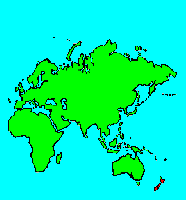SPECIES INFO
Greater broad billed moa (Dinornis gravis to Euryapteryx gravis) was found on both the North and South Island in New Zealand. This species or a closely related species was found on Stewart Island. This bird was probably about the size of the modern ostrich. The bones of this species appear more commonly than bones of most other moas. This moa probably went extinct about 1700 or 1800. This moa probably stood about 6 feet in height.The Euryapteryx genus contains species of extinct birds that were found in New Zealand. These birds were called moas. Members of this genus were previously found under genera such as Emeus and Dinornis.
Kiwi Family (Apterygidae) contains three different species of Kiwis. (Recently divided into 5 species by some authors.)
These small flightless birds have no breastbone, and taxonomists place them near the extinct Moas that lived in New Zealand about 750 years ago. The Kiwi is the national symbol of New Zealand. The introduction of non-native animals to New Zealand is having a serious impact on wild populations. However, the species are protected.
Although we are following Sibley and Monroe, it would appear that the missing breastbone is very significant, and we expect the grouping of the kiwis into the Struthioniformes is more of a convenience than a logical conclusion. We, however, like this grouping as it reduces the number of orders and permits easier study of bird taxonomy.
In older works, the ostrich, rheas, cassowaries (including the emu), and kiwis were each given their own order. In newer works there are numerous methods of grouping these flightless birds together. Herein we have followed Monroe and Sibley 1993 wherein these flightless birds were each given family status and grouped into the Struthioniformes order.
Aves contains about 8,650 different species of living birds known to science. Each year about one new species is discovered in some remote rain forest or remote island. In addition, scientists have been raising many subspecies to full species status which may raise the species count to 10,000. Birdlife recognizes 10,027 species as of 2011.
However, each year about one species goes extinct. The rate of extinction is increasing, and the rate of new discovery is decreasing, so that the number of bird species will soon begin to decline rapidly. Although different taxonomists would organize the birds differently, there are approximately twenty-seven orders of birds. These orders are broken down into about one hundred and fifty-five different families.
Recent research of the genetic structure of some of the shore birds and owls would indicate that the present organization of orders and families should have some modification.
The birds are a worldwide group of animals that are characterized by having the front limbs modified into wings that are used for flying. Perhaps the most unique feature of the birds is the feathers. These feathers are made up of a central support called a quill and a series of small filaments that are hooked together as barbs.
For many years it was believed that Archaeopteryx discovered in Bavaria was the oldest bird from about 150 million years ago. However, in l986, Sankar Chattterjee, a Texas paleontologist, reportedly discovered a bird in the genus Protoavis that lived about 225 million years ago.
When this project was begun in 1978, we used Austin & Singer for bird taxonomy. Since then, we have adopted many changes, but have kept some older concepts that are still found widely in the literature. Recently, we have used Clements and Howard & Moore. Very recently, we have used Monroe and Sibley for the higher taxonomy of the perching birds.
Backboned Animals (Phylum Chordata) are the most advanced group of animals on earth. These animals are characterized by having a spinal cord or backbone. Most members have a clearly defined brain that controls the organism through a spinal cord. Fish, amphibians, reptiles, birds, and mammals are in this phylum.
Currently, some taxonomists believe that the fish should be divided into two groups (sharks and regular fishes) and that there are some other primitive groups in the phylum such as hagfish or lampreys.
Animal Kingdom contains numerous organisms that feed on other animals or plants. Included in the animal kingdom are the lower marine invertebrates such as sponges and corals, the jointed legged animals such as insects and spiders, and the backboned animals such as fish, amphibians, reptiles, birds, and mammals.

